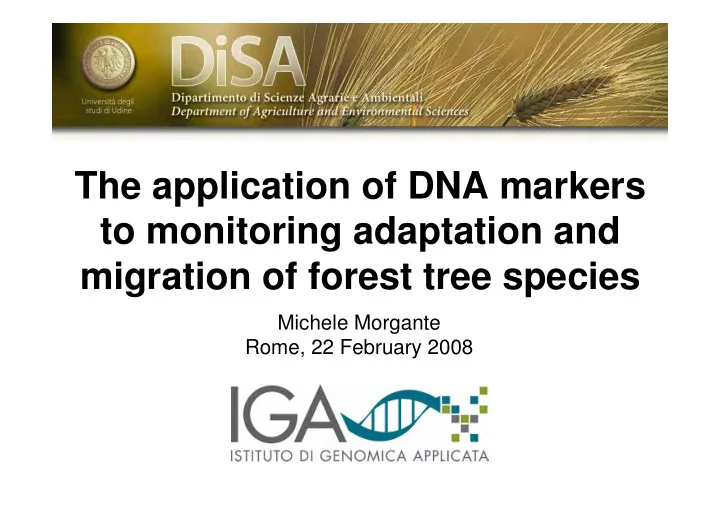

The application of DNA markers to monitoring adaptation and migration of forest tree species Michele Morgante Rome, 22 February 2008
WHAT IS GENETIC VARIABILITY?
GENETIC VARIATION = SEQUENCE VARIATION CHR-A cAAaTTATTA ATAATTTGGT TCCAtAATTG CGTTGCACTT CGTTATAGCG CHR-A cAAaTTATTA ATAATTTGGT TCCAtAATTG CGTTGCACTT CGTTATAGCG CHR-B aAAtTTATTA ATAATTTGGT TCCAtAATTG CGTTGCACTT CGTTATAGCG CHR-B aAAtTTATTA ATAATTTGGT TCCAtAATTG CGTTGCACTT CGTTATAGCG CHR-C aAAtTTATTA ATAATTTGGT TCCAgAATTG CGTTGCACTT CGTTATAGCG CHR-C aAAtTTATTA ATAATTTGGT TCCAgAATTG CGTTGCACTT CGTTATAGCG CHR-A .aaaaaAAAA AAAAAAATAC TTATTCGATC CTATCTGTTC TCATTCCAAT CHR-A .aaaaaAAAA AAAAAAATAC TTATTCGATC CTATCTGTTC TCATTCCAAT CHR-B ......AAAA AAAAAAATAC TTATTCGATC CTATCTGTTC TCATTCCAAT CHR-B ......AAAA AAAAAAATAC TTATTCGATC CTATCTGTTC TCATTCCAAT CHR-C aaaaaaAAAA AAAAAAATAC TTATTCGATC CTATCTGTTC TCATTCCAAT CHR-C aaaaaaAAAA AAAAAAATAC TTATTCGATC CTATCTGTTC TCATTCCAAT CHR-A TGATCtTCCA TTTCTGGAAC CAtcAATAAA TAATTTGATG GAGTATCTAA CHR-A TGATCtTCCA TTTCTGGAAC CAtcAATAAA TAATTTGATG GAGTATCTAA CHR-B TGATCtTCCA TTTCTGGAAC CAggAATAAA TAATTTGATG GAGTATCTAA CHR-B TGATCtTCCA TTTCTGGAAC CAggAATAAA TAATTTGATG GAGTATCTAA CHR-C TGATC.TCCA TTTCTGGAAC CAggAATAAA TAATTTGATG GAGTATCTAA CHR-C TGATC.TCCA TTTCTGGAAC CAggAATAAA TAATTTGATG GAGTATCTAA • Nucleotide substitutions (SNPs), INDels (insertion/deletions) • Nucleotide substitutions (SNPs), INDels (insertion/deletions)
FUNCTIONAL VARIATION Coding variation Regulatory variation Allele A Allele A Allele B Allele B
Nucleotide diversity in forest tree species Savolainen and Pyhäjärvi, 2007
Analysis of of Norway Norway spruce spruce nucleotide nucleotide diversity diversity and and Analysis demographic history history demographic 7 7 populations populations: : Sweden (North) (North) Sweden Russia Russia Sweden (South) (South) Sweden Romania Romania Germany Germany Switzerland Switzerland Italy Italy Glacial refugia Sampled pops. Modified from Lagercrantz & Ryman (1989) Recolonization and Schimdt-Vogt (1977) routes
�������� ���������� ���������� ������� ������� ����������� ����������� �������� ��������������� ����� � � ������������������������������������������������������ ��� ��� !"# $����� ������ �%������&'�����(�)���(�*����������# � �� ������ �������� � �� ������ � �� ������ Heuertz et al., Genetics 2007
+��������� ����,��� ����,��� �� �� ���������� ���������� ��������� ��������� +��������� Cluster 3 Cluster 3 Romania Romania Romania Baltico-Nordic domain Baltico-Nordic domain Baltico-Nordic domain Alpine domain Alpine domain Alpine domain Severe bottleneck occurred several hundred thousands years ago Heuertz et al., Genetics 2007
Analysis of of Scots Scots pine nucleotide pine nucleotide diversity diversity and and Analysis demographic history history demographic Low differentiation btw. populations Sequence data consistent with an ancient bottleneck (>1 Myrs) Pyhäjärvi et al., Genetics 2007
Neutral variation analysis • Allows reconstruction of migration routes in the postglacial era • Allows inferences on past bottlenecks/demographic events • Norway spruce and Scots pine – Moderate nucleotide diversity – Most variation within populations – Low btw. population differentiation – Deviations from neutrality consistent with ancient bottlenecks
Adaptive variation analysis • The elusive variation • Hard to identify adaptive genes • High differentiation between populations for adaptive traits • Progresses from association genetics approaches
Clinal variation for bud set in Norway spruce 130 130 Qst = 0.716, S.E. = 0.08 120 120 Days to bud set Days to bud set Days to bud set Days to bud set 110 110 100 100 mean mean 90 90 al a al a yl ä yl ä 80 80 70 70 60 60 50 50 45 45 50 50 55 55 60 60 65 65 70 70 latitude latitude latitude latitude K. Karkkainnen, TreeSnips EU project
Clinal variation for bud set in Scots pine K. Karkkainnen, TreeSnips EU project
NEW APPROACHES TO TRAIT MAPPING: ASSOCIATION MAPPING – Can be done on individuals from “natural” populations – Takes advantage of historical recombination events – Assumes “sufficient” linkage disequilibrium – Made possible by high marker density: SNPs – Can achieve high resolution
Linkage Disequilibrium Disequilibrium (LD) (LD) Linkage Definition: association/correlation between alleles at different loci Natural population �������������������������������� �������������������������������� Ind#1 Ind#2 Ind#3 Ind#4 Ind#5 Ind#6 Ind#7 Ind#8 LD ↑ LD ↓
Scoring the bud set phenotype in poplar Bud-set Score Card Populus nigra The collection has been scored for bud set according to a new phenology score card for high-resolution phenotypic data (Rohde et al ., unpublished), which delineates 7 developmental stages.
Timing of bud set in Populus nigra 4 traits derived from the raw scores: - duration of bud set process from score 3 to score 1.5 (duration_subproc1) - duration of bud set process from score 1.5 to score 0 (duration_subproc2) - date of onset of score 2.5 (date_25) - distribution of scores at day 276 (score276) • clinal variation for 2 traits North populations South North populations South (Rohde et al ., unpublished)
Bud set variation in Populus tremula Ingvarsson et al. 2006; Ingvarsson et al. 2008
Phytochrome B2 SNPs associate with time to bud set in aspen Both SNPs show high Fst and clinal variation and explain between 1 and 5% of phenotypic variation Ingvarsson et al., Genetics 2008
Conclusions • Progresses in sequencing technologies allow direct detection of sequence variation • Useful for studying demographic phenomena (migrations, bottlenecks) • Useful for studying adaptive phenomena (but here we need to find adaptive genes/mutations) • Nucleotide variation not only type of sequence variation: structural variation and TEs • Next generation sequencing will revolutionize the field
Recommend
More recommend